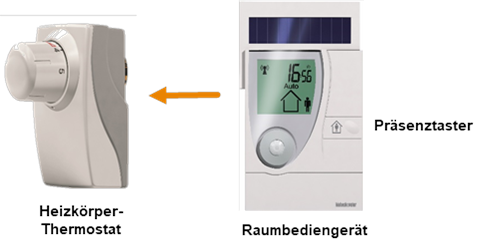University administration: Installation of individual room control from 22.10.24
From Tuesday 22.10.24 an individual room control system will be installed in the rooms of the university administration and the extension. The installation will take place in several steps and is expected to be completed by the end of November
The installation per office will take approx. 15 minutes.
The installation of the room control unit in your office next to the door may cause temporary noise if the fixing has to be drilled into the brickwork. The resulting dust will be extracted immediately.
Please allow the installers free access to the radiator thermostats. Please coordinate with the installers on site if installation is not possible at the planned time. This will then be carried out at a later date.
Installation takes place from the 4th floor downwards.
Queries to:
Jan Köster
Tel: +49 561 804-3738
Mail: Jan.Koester[at]uni-kassel[dot]de
The individual room control
The use of individual room control reduces heating energy consumption by lowering the room temperature when the room occupants are absent.
The operation of your room heating does not change, the new components just have a slightly different design. As is the case today, the desired room temperature is set via a radiator thermostat. Here too, the setting value "3" corresponds to an internal room temperature of around 20 °C.
Attention! The setting is possible from 1 to 4. This prevents the room from overheating or cooling down too much.
 Image: Fa. Kieback&Peter GmbH & Co. KG
Image: Fa. Kieback&Peter GmbH & Co. KGIf the room is not in use due to mobile working, vacation or illness, the room temperature is lowered by 4 Kelvin (°C). This results in the desired energy saving.
This is made possible by a room control unit that is installed next to your door. A presence sensor and a presence button are integrated into this. The presence button can be used to communicate presence or absence directly to the system in order to activate a temperature change.
The presence sensor integrated in the room operating unit creates a time profile for probable occupancy of the room based on past room use. If there is a high probability of occupancy, the room is heated in advance to the room temperature set on the radiator thermostat.
If the room is not being used, the room temperature is lowered again after a certain period of time.
The integrated presence sensor does not record any individual or daily presence or absence. Only a weekly calendar is stored in the room control unit, which shows the probability of room usage for time windows of 15 minutes based on previous usage. The room controller uses this calendar to decide the operating status of the room. Manual intervention via the presence button is possible at any time. The heating is not lowered during the period in which the presence sensor detects movement.
The room operating units in each office communicate exclusively with the assigned radiator thermostats. Furthermore, these are autonomous on a room-by-room basis and are not connected to a higher-level system.
The use of this system was agreed in advance with the Department of Human Resources and Organization, the Staff Council and the University of Kassel's data protection officer.
The identical components are also in operation in many other public buildings, schools, municipal administrations and other universities.
By the way:
The devices do not require a battery change, as the required energy is generated in the radiator thermostat from solar cells and "energy harvesting", from the temperature difference between the room and the heating water.

